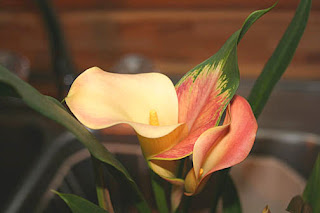
The weather gods smiled on Nova Scotia again today and presented us with a hot, sunny day; ideal for heading off to the south shore, to the lovely community of Port Mouton (pronounced Ma-tooon, although it is French for sheep so you’d think it would be Mooton, right? It’s a Nova Scotian thing…). I was giving a talk to the lovely ladies and gentlemen of the south shore district of the Nova Scotia Association of Garden Clubs. The famous south shore hospitality was in full bloom and we had a great day. The meeting was hosted by the Queens County Gardeners, a wonderful group of green thumbs, and held at Coastal Queens Place, the old schoolhouse which is now a public community access site, a small library, and a craft agora, as well as a marvelous hostel! It’s so good to see old schools restored and kept as the heart of a small community.
Before we got there, of course, we landed at a couple of garden centres. First stop was the remarkable Pine View, in Bridgewater. This is a very large and very diverse, full service garden centre, with a huge collection of annuals, perennials, shrubs and trees. I was focused on looking for a few different annuals to include in my talk, and then of course I can’t pass up perennials ever…and found a few that needed to get in the car too.
 I’ll report on those next posting, but for now, here’s a marvelous lantana (I’ll bring the tags in from the greenhouse in the morning).
I’ll report on those next posting, but for now, here’s a marvelous lantana (I’ll bring the tags in from the greenhouse in the morning). Beautiful place, the only fly in the oinment being a very rude staffperson who snapped at my longsuffering spouse, “this area is for employees ONLY!” He was standing off to one side near some building, waiting for me to stop drooling over perennials, apparently near a potting shed or something. Well, this was his first visit to the garden centre, he didn’t know his way around, and he was just STANDING there! So that was a bit offputting, and she’s lucky I didn’t hear her rudeness. Maybe she hadn’t had her coffee yet. The staff I dealt with were marvelous.
Next stop was Ivan Higgin’s in Liverpool, which is called Cosby’s Garden Centre. I’ve mentioned Ivan before: he’s a whiz of a garden centre operator, plus an artist par excellence, sculpting the most amazing figures out of his own special concrete mixture.
 These are lifesize sculptures, his winter’s project: I call them Cirque du Ivan! His tulips are still in peak conditions; these brilliant beauties caught my eye, even thought they’re not species tulips,
These are lifesize sculptures, his winter’s project: I call them Cirque du Ivan! His tulips are still in peak conditions; these brilliant beauties caught my eye, even thought they’re not species tulips,  I was very well behaved (fiscally, that is) at Ivan's today and only bought one plant. But I’ll be back next week…and have my eye on one of his concrete wind gods…
I was very well behaved (fiscally, that is) at Ivan's today and only bought one plant. But I’ll be back next week…and have my eye on one of his concrete wind gods…After we were done in Port Mouton, even though I’m still full of flu or bronchitis or pneumonia or whatever the heck it’s morphing into, my dearly beloved and I did go a bit further down the shore, as I wanted to go to Lavender Hill in Jordan Falls. This is another jewel of a nursery, a family business, and while it was sweltering hot by this time, we enjoyed visiting with Madeline and Alison, the owners, and picking out a few more choice plants. They always have a wide selection of really excellent plants, usually something I’ve never seen before and I took them out to the car to show them some of the interesting oddities I’ve collected along the way. It’s a challenge for smaller nurseries to get a huge variety in, when they have to buy a minimum of say 100 of a nemesia or a portulaca or a lobelia, and what if people aren’t into new things? SO I take it on as goal to encourage people to try new things—and mostly, people just need to see something new put together in containers to get excited and go for their own colour adventures.
After we left Lavender Hill (with a dozen happy lavender seedlings in the back seat along with other great finds), we headed back up the shore. It was really hot, and I sooked that I needed to go walk in the water at Beach Meadows beach near Liverpool—surely one of the most beautiful beaches in our province.

Some adventurous souls further down the pristine beach were in swimming—or at least splashing—but I contented myself with just walking in the water up to my ankles, and admiring the still life portraits of seaweeds. There are at least six different species of seaweed in this photo—a rainbow of colours, from the underwater tapestry so many will never see. These broke loose in the tide and the gales of wind recently, and swept up the beach. While they’re in water they pulse and heave and shimmer; then once beached they dry and become excellent fertilizer for gardens, or just nutrients returned to the sea. That circle of life thing again.

Back home, the gardens seemed to have grown six inches taller today, and things are eagerly waiting to be planted, including the new treasures we brought home today. Now I’m blissfully tired, being serenaded by spring peepers, and ready to sleep—without thunderstorms tonight, please!














































